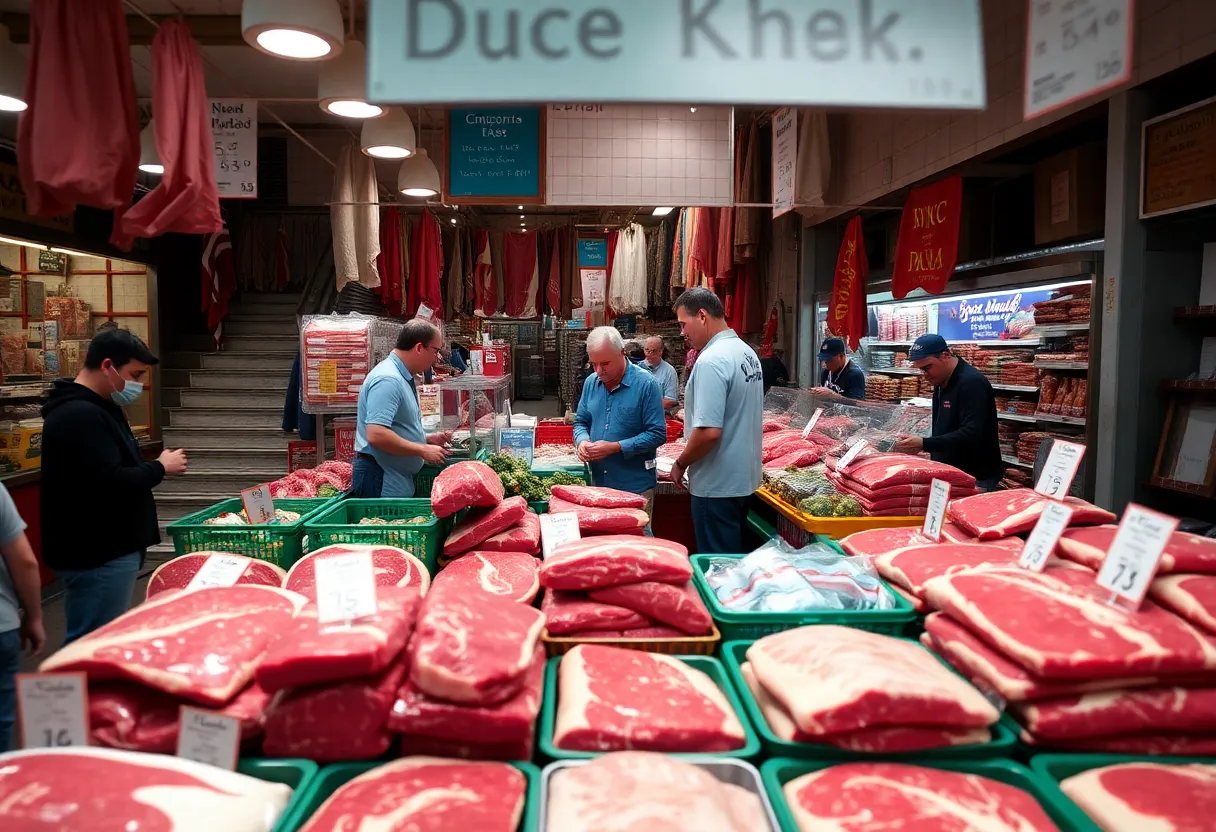News Summary
California is witnessing a significant rise in beef prices, influenced by dwindling cattle herds and increasing consumer demand. The average price for ground beef has reached $6.12 per pound, a 12% increase from last year. Vendors face challenges maintaining stock, as their inventory often falls short of demand. Concurrently, ranchers benefit from higher profit margins. The decrease in the U.S. cattle herd, alongside factors like drought and rising operational costs, contributes to ongoing supply challenges. As consumer habits shift towards alternative meats, California’s meat market is evolving.
California is experiencing a significant rise in beef prices, driven by a combination of shrinking cattle herds and surging consumer demand. Over the past year, the price of beef and steak has increased, leaving ranchers with higher sales but vendors struggling to maintain adequate stock on shelves.
The average price for a pound of ground beef has reached $6.12 as of June, reflecting a 12% increase compared to the previous year. Similarly, the average price for uncooked beef steaks has risen by 8% to $11.49 per pound. Northern California vendors, such as Mad Butcher Meat Co., face challenges as their inventory often fails to meet customer demand due to short supplies.
Despite ranchers enjoying favorable profit margins amid these higher selling prices, vendors experience instability in pricing and inventory levels that make it harder to fulfill orders. Daily inventory received by Mad Butcher frequently falls short of full orders, showcasing the inventory crisis faced by meat vendors in the area.
The decrease in the U.S. cattle herd, currently at its lowest numbers since 1951, contributes significantly to these supply issues. Factors such as prolonged droughts, inflated feed costs, and high slaughter rates of female cattle have all compounded the problem. Cow production is noted to be at its lowest levels in 60-70 years. As the drought conditions improve and grain prices potentially stabilize, ranchers may expand their herds, but the process takes considerable time.
Moreover, consumer purchasing habits are shifting in response to the escalating prices of beef. There has been an uptick in the purchase of alternative meats, such as pork, chicken, and turkey. Furthermore, prices for beef organs, including liver and hearts, have begun to rise, reaching levels comparable to those of ground beef and steak.
Furthermore, the emergence of the New World screwworm fly in Mexico has negatively affected cattle imports, placing additional strain on the available supply. Prospective tariffs on imported beef could further elevate prices, resulting in increased costs for meat packers and ultimately consumers. However, consumer demand for beef does remain robust, especially during the summer’s grilling season, indicating that despite the high prices, it continues to be a preferred choice among many.
Ranchers express that the higher selling price of cattle can compensate for increased operational costs, thereby resulting in higher profit margins than previously experienced. However, vendors like Mad Butcher find it essential to adjust their prices weekly based on fluctuating operational costs, adding to the unpredictability within the market.
In summary, California’s beef prices are on an upward trend, influenced by a combination of shrinking cattle inventories and rising consumer demand. Vendors are grappling with stock shortages, while ranchers are benefiting from larger profit margins, setting the stage for continued shifts in the meat market landscape in the foreseeable future.
Deeper Dive: News & Info About This Topic
- KCRA: Rising Beef Prices in California
- Wikipedia: Beef
- NerdWallet: Why Is Beef So Expensive?
- Google Search: Rising Beef Prices
- NBC DFW: Beef Prices Have Soared
- Google Scholar: Beef Prices California
- Fresno Bee: Local Beef Prices Report
- Encyclopedia Britannica: Cattle
- Daily Journal: Beef and Bioreactors in California
- Google News: Beef Market Trends

Author: STAFF HERE HOLLYWOOD
The Hollywood Staff Writer represents the experienced team at HEREHollywood.com, your go-to source for actionable local news and information in Hollywood, Los Angeles County, and beyond. Specializing in "news you can use," we cover essential topics like product reviews for personal and business needs, local business directories, politics, real estate trends, neighborhood insights, and state news affecting the area—with deep expertise drawn from years of dedicated reporting and strong community input, including local press releases and business updates. We deliver top reporting on high-value events such as the Hollywood Bowl summer concerts, the Hollywood Christmas Parade, film premieres at TCL Chinese Theatre, and festivals at the Magic Castle. Our coverage extends to key organizations like the Hollywood Chamber of Commerce and Visit Hollywood, plus leading businesses in entertainment, dining, and tourism that define the local economy. As part of the broader HERE network, including HERELosAngeles.com, HEREBeverlyHills.com, HEREAnaheim.com, and HEREHuntingtonBeach.com, we provide comprehensive, credible insights into Southern California's dynamic landscape.





